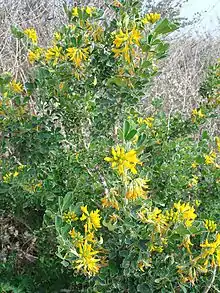| Medicago arborea | |
|---|---|
 | |
| Scientific classification | |
| Kingdom: | Plantae |
| Clade: | Tracheophytes |
| Clade: | Angiosperms |
| Clade: | Eudicots |
| Clade: | Rosids |
| Order: | Fabales |
| Family: | Fabaceae |
| Subfamily: | Faboideae |
| Genus: | Medicago |
| Species: | M. arborea |
| Binomial name | |
| Medicago arborea | |
| Synonyms | |
| |
Medicago arborea is a flowering plant species in the pea and bean family Fabaceae. Common names include moon trefoil, shrub medick, alfalfa arborea, and tree medick. It is found throughout Europe and especially in the Mediterranean basin, primarily on rocky shores among shrubby vegetation. It forms a symbiotic relationship with the bacterium Sinorhizobium meliloti, which is capable of nitrogen fixation. It is the only member of the genus Medicago which is used as an ornamental. M. arborea is sometimes misidentified as Cytisus, which it resembles.[1]
Description
The shrub is 1–4 metres (3 ft 3 in – 13 ft 1 in) high and wide and is pale yellow in colour. Its stems are erect and terete while its stipules are triangular and are 5–8 millimetres (0.20–0.31 in) in height. Its petioles are 2–4 centimetres (0.79–1.57 in) long with obovate to obcordate leaflets. Flowers are scattered 6-10 racemes and are 2–2.5 centimetres (0.79–0.98 in) long with axillar peduncles which are 3–5 centimetres (1.2–2.0 in). The corolla is of orange colour and is 12–15 millimetres (0.47–0.59 in). Bracts are 2 millimetres (0.079 in) long while its pedicels are 5 millimetres (0.20 in) long. Its legume is coiled in 0.5 to 1.5 spirals which are 12–15 millimetres (0.47–0.59 in) wide and are pubescent at the center. The seeds are 4 millimetres (0.16 in) long.[2]
References
- ↑ Lesinš, Karlis Adolfs; Lesinš, Irma (1979). Genus Medicago (Leguminosae). The Hague, The Netherlands: Dr. W. Junk bv Publishers. p. 132. ISBN 90-6193-598-9.
- ↑ "Medicago arborea". 778 (1753). Flora of China.
{{cite journal}}: Cite journal requires|journal=(help)
External links